Originally posted by curtisbyrne
View Post
Announcement
Collapse
No announcement yet.
Project: Argoceptor
Collapse
X
-
Yeah, pretty sure I’m going to go with a custom fiberglass hood:

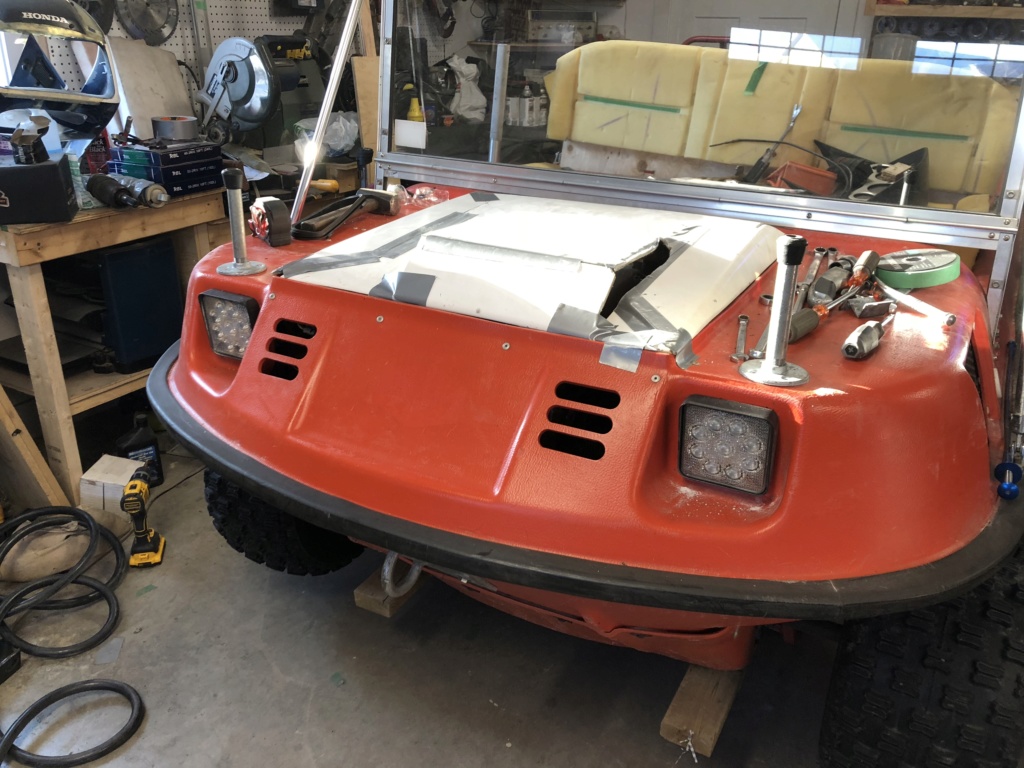
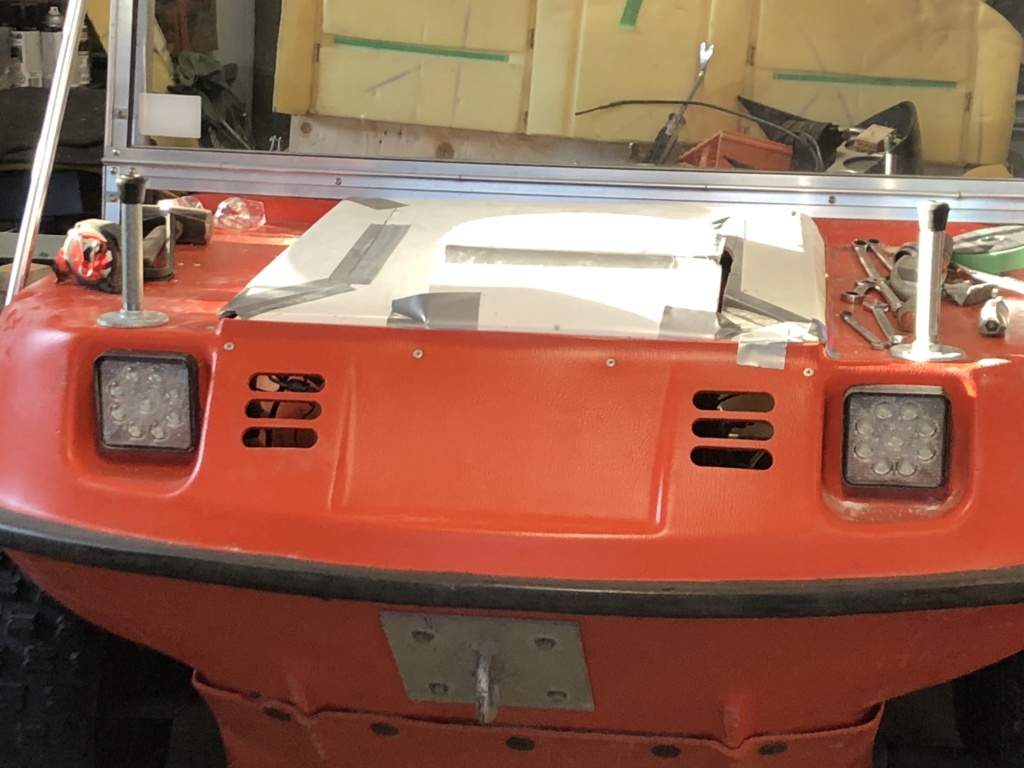
Sorry about the crap pics, the sun choose that exact moment to clear and come right in the window directly on the hood.
Thats just a rough mock up, but you can see the shape. The bulge over the airbox will be rounded off and blended into the rest of the hood so it looks like it should be there. It’s just stsndsrd fiberglass procedures to get it the way I want it and I’m pretty good with ‘glass....
Its just going to be easier to rework the fiberglass into something that looks like its supposed to be there as opposed to the stock hood with some kind of “spacer” to get it high enough to clear the airbox.
That the entire rear of the fiberglass hood is wide open is a big plus for shedding engine bay heat and I always have the option of adding additional venting to the rest of the hood surface if I need it.

Comment
-
Not a problem. If the mufflers go under where I’m planning to put them, I’ve got bigger problems as the water is pretty much coming in over the transom already. Even if they do get “dipped”, as long as the engine is running its not a problem. Exhaust flow keeps most of the wet stuff out and what does get by evaporates in the hot exhaust shortly after.Originally posted by curtisbyrne View Postexhaust exiting the rear seems like a pain but super cool. the only problem i can see is being in water and exiting or entering on an incline where the tail pipe ends up in the water? just a thought. a stack would be coolio or even just the duals out the side?
 Last edited by great white; 12-07-2018, 07:25 PM.
Last edited by great white; 12-07-2018, 07:25 PM.
Comment
-
Didn't do much to the Argo today. Fiberglassed the hood pieces back together and started a wire frame for the hood blister:
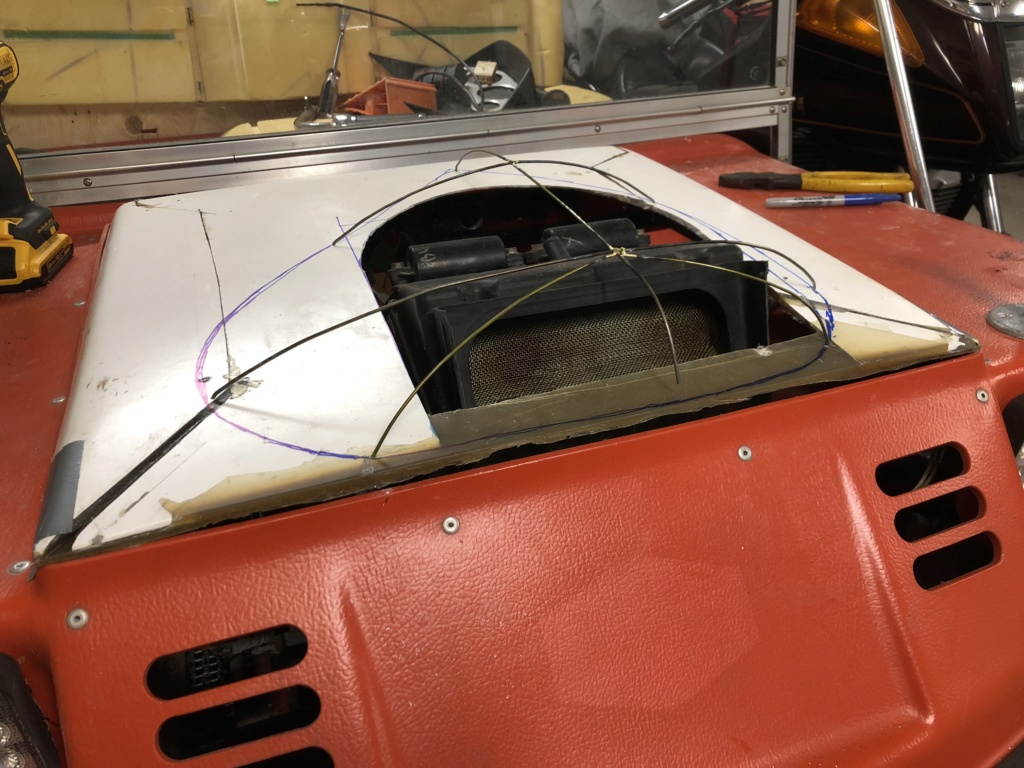
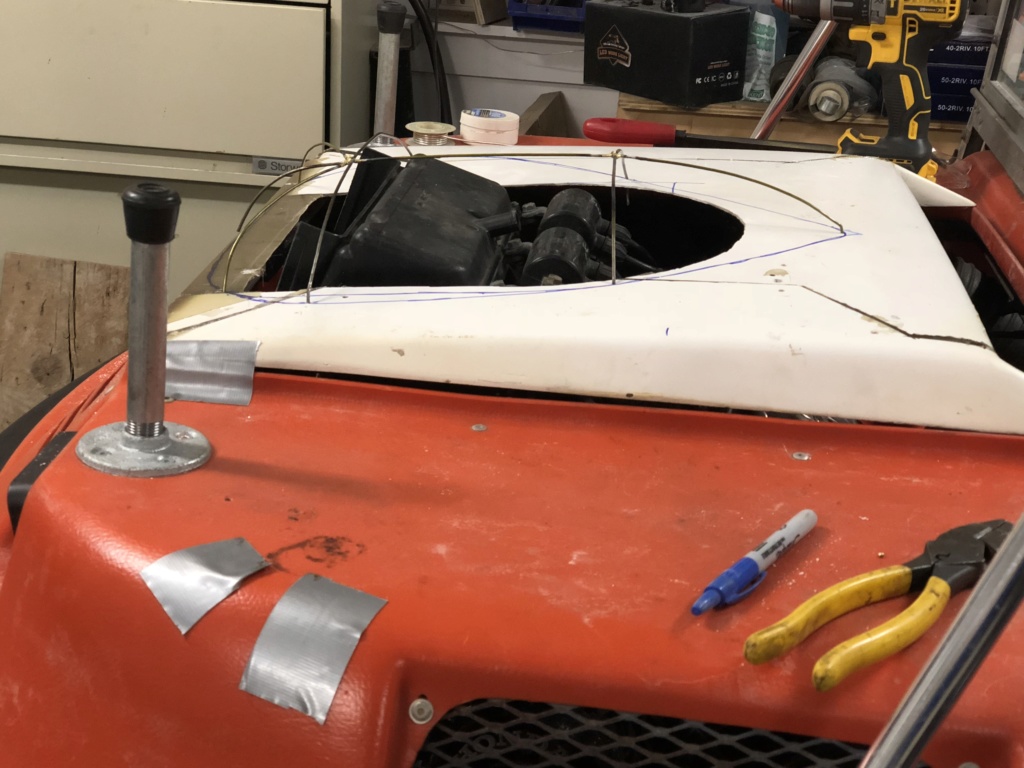
Just a start, but you can start to see the shape. Its mostly like a fat teardrop.
The one side is kicked out wider to accommodate airbox ducting. I decided there was no other way to make it fit and look good than to duct the airbox.
So the plenum of the airbox over the carbs will remain unchanged, but the filter will be relocated to the RH side of the engine and ducting connecting the plenum to the air filter housing. Hopefully, that won’t change the airbox characteristics too much to the point where I have to get down in to the carb body casting ports to make it run right.
If it becomes too much of a problem, I may just yank the 4 keihins and drop a custom manifold and a small 2bbl (think: Volkswagen bug) on there. Then its a straight cable actuated carb instead of CV slides and not as hypersensitive to airbox chages. I may loose some HP off the top end. But seeing as I’m starting with 90hp, i can loose 30 hp and still be at 60hp. Hp peak is up around 9 grand and I’ll never be there anyways (or at least I SHOULDN’T be there in an argo!). Even 60hp is more than enough and a single 2bbl might actually improve lower end torque.
Comment
-
OK, so the way this is going, I could very well end up with the "fastest" Argo 8x8 ever built.
On land at least.
In the water though, its still going to be a 2-3 mph slug-fest. That seems kind of like dating a beautiful girl with a fat ass. Starts out great, but just disappointing in the end...
So I'm thinking I need to do something about the water speed. This is all just me tossing ideas around, so nothing is out of bounds. It's also a VERY long term thing, if I do it at all.
Problems opposing water speed are many:
1. Displacement hull.
They only go so fast and the shorter the hull and blunter the stern, the slower it goes.
2. Propulsion.
Yeah, eight churning tires are only even going to produce so much thrust and it's a pathetic amount at that.
3. Drag.
Kind of part of #1 and #2, but those eight tires hanging out there are drag monsters, even when turning.
So, what to do about those issues:
1. Displacement hull.
There's really only one way to deal with the argo's hull; get it up and out of the water. That means getting it on plane. That means thrust and hydrodynamic drag reduction. Getting it on plane is also a balance issue, as the Argo is quite nose heavy in the best of conditions.
2. Propulsion.
Couple routes here. I could power a jet drive off the V45 engine or I can just hang an outboard with enough power on it. Jet drive off the existing powertrain is appealing from a weight perspective, but an outboard is attractive from the simplicity angle. Outboard also gives me lots of trimming options and steering is simple. I'd have to devise a way to raise and lower it every time I enter water deep enough to use it. Tires will still work fine for short crossings though.
3. Drag.
The 300 pound gorilla sitting in the corner of the room. it's those tires really. Not a chance in hell of getting it up on plane while those tires are (essentially) the bottom surface on the rig. Too much drag, too much turbulence. But, I may have a way around it. The rig will eventually get a suspension. Which means the tires will be capable of raising and lowering on their A arms. If I make a "frame" under the hull, I can devise a way to lift the tires up to as far as they will go, have a "slide out" foil surface under them and possibly eliminate the darg component and give it a chance to get on plane.
It's not outside the realm of possibility to get it on plane. Vehicles like the Gibbs Quadski and Terraquad already use the same type of scheme (ie: retract tires, motorcycle engine, jet drive) and you can get the kitchen table up on plane if you do wanted to. Sure, the Gibbs amphibs (and any other similar rig) are a compromise and does both roles OK but neither stellar. But the Argo is already a compromise in the same fashion, although it can be argued it is biased towards land performance instead of water.
So the question is: can I build it in the garage and still have the whole rig usable and not a temperamental pile of cra.........err, junk.
Like I said this is just spit balling. There's a couple years worth of work on the engine and suspension before I can even consider looking at water speed increases.Last edited by great white; 12-09-2018, 01:38 PM.
Comment
-
Well, I need to go from the chain drive V45 to the belt driven argo transmission. I also need a way to minimize shock loading on the argo transmission when using a chain drive.
So, take one CBR/F2 rear wheel and cut the center out:
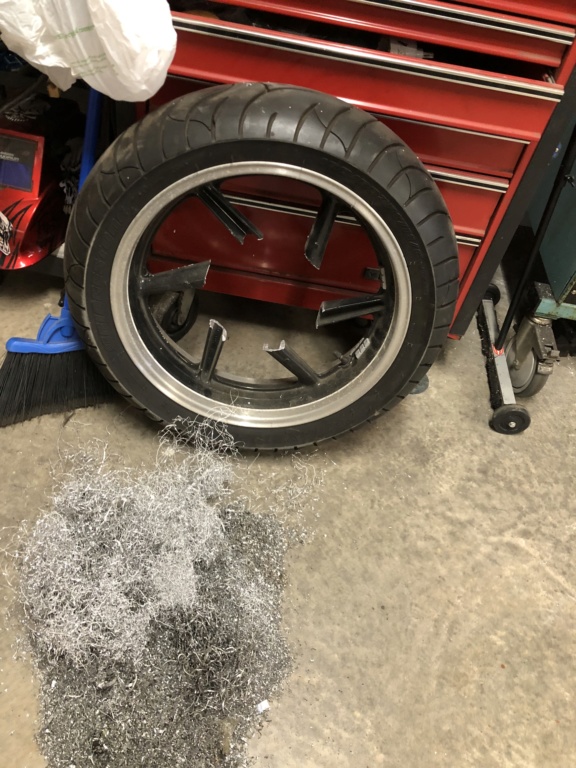
Right about now there’s a team of VF and CBR owners furiously google-ing for my address and forming the lynch mob! Lol!
Chuck the resulting lump up in the lathe and turn it down to the pieces that I need:
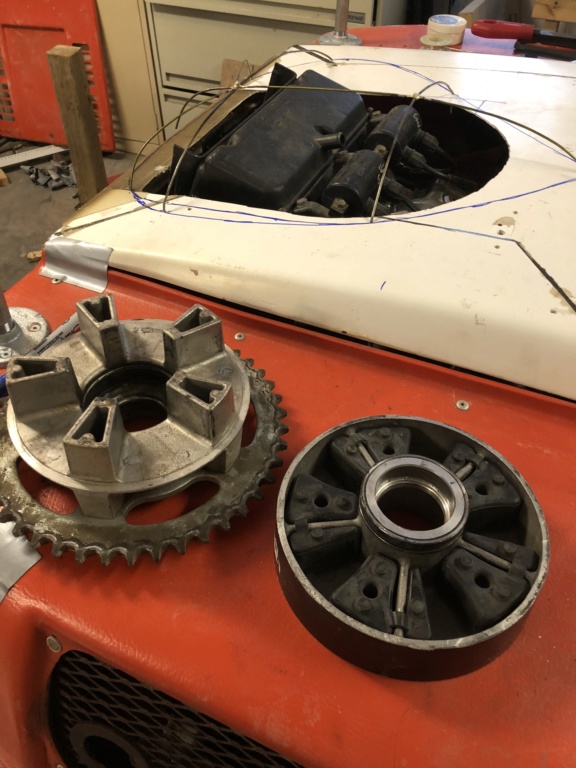
You can see the rubber “dampers” that absorb the chain shock loads. They also let the sprocket carrier "float" a tiny bit to account for small misalignment with suspension action. In my case, it will afford some tolerance if/when the Argo frame "flexes".
Assemble the bits:
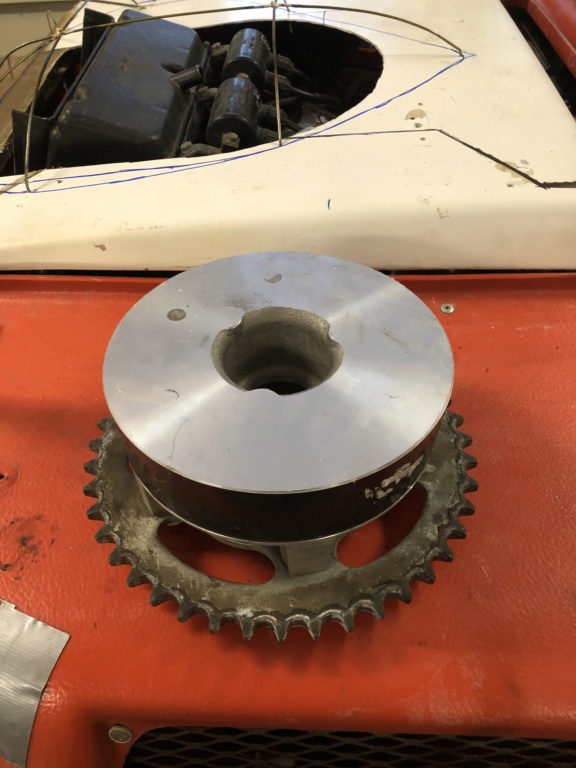
Perfect!
Test fit on the Argo input shaft:
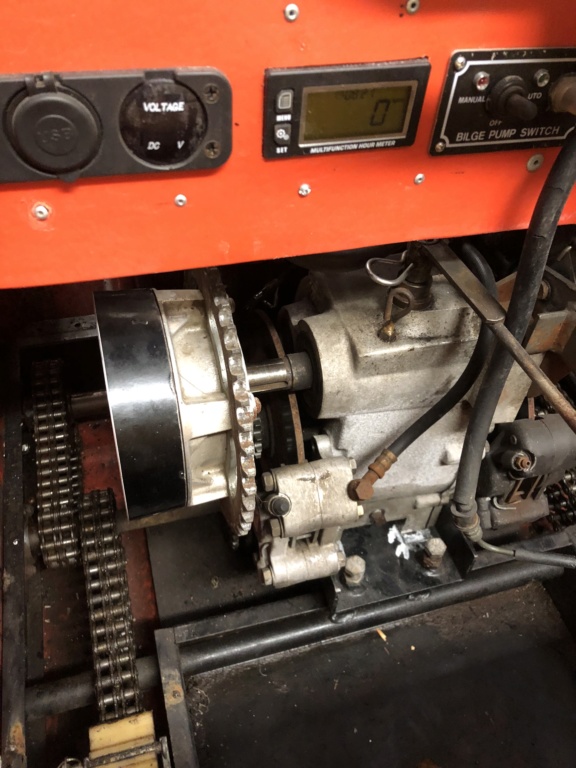
That's going to work nicely!
Last piece I have to make is a steel adapter to fit the center bore in the aluminum wheel hub to the Argo input shaft. It will be attached to the Argo shaft the same way the CV driven clutch is built: aluminum sheave with a steel center pressed in and keyed to the Argo gearbox.
Coming together nicely.

Comment
-
So I'm thinking more about the getting the argo hull to plane in the water.
As mentioned, with the suspension build comes the opportunity to make the wheels retractable. At least enough to raise them above the bottom of the hull, if not out of the water. Suspension is relatively easy to design, but retracting suspension is a fair bit more work.
So before I put any thought in to a retracting suspension, I think I need to find out if the hull can be reasonably made to plane in the first place. So I think I have a plan to test if the hull will plane (and be controllable) before even striking the first arc.
This summer, I'll take it down to the water, drop an outboard on the back, remove all 8 wheels and see it the sucker will "get up on step" as a hull. If it will get up on plane, then I at least know I have something I can work with. The axles will still be sticking out, but a big hopefully they won't be as much an impediment to planing as the tires.
If the hull refuses to plane without anything bigger than a 10-15 Hp outboard, then I can abandon the thoughts of trying to make it plane at all and just build a fixed suspension under it. If I have to settle for a fixed suspension and no plane, I'll just have to settle for displacement hull speeds around 2-5 mph....
Comment
-
Ok, stay with me on this one. It's going to get a little weird for the uninitiated.
More thoughts on water speed.
This is probably going to sound right out in left field if you use your Argo for hunting or hauling stuff. Heck, It may sound nuts even if you just use it for fun.
Looking at the Argo and options for getting it on plane, I just don't think it will happen. Even if I make the wheels retract up above the bottom of the hull, the front 3 sets will still be underwater(and most of the fourth set as well). That means drag, lots of it. It very likely means I won't be able to get enough power on it to get it up on plane. If it did plane, the power requirement goes waaay down (and speed goes up), but I just don't think I'm going to be able to overcome the drag to get it there.
Now, crazy idea time:
Hydrofoil.
A hydrofoil works by lifting the craft out of the water. Beauty of them is, they don't require a lot of power to create that lift. The foil under the water ifs a wing and the camber can be adjusted to create more or less lift (there are drag penalties, but nothing like eight tires).
Once the hull is up out of the water, the drag of the tires goes away and the power requirements goes even lower to keep it up on the foils. You have a foil in the front in the water, foils in the back and the prop/leg from the outboard and that's it. Everything else is clear of the water.
Obviously, it has to be retracting or folding, or the land performance of the Argo is negatively impacted. It's also only going to be good for travel on lakes or waters of some depth. You don't need deep water to operate a hydrofoil, but you need 4 or 5 feet of depth to deploy it.
I've built a lot of stuff over my 53 years, but never a hydrofoil. At least nothing bigger than an RC model. I gotta say, I'm kinda swayed towards trying it for the challenge if nothing else. I've always liked the story of the "flying 400", a hydrofoil warship sea trialed right here in my home province:

Named "HMCS Bras 'Dor" after the Bras 'Dor lakes in Cape Breton, where Alexander Graham Bell built and flew hydrofoils and eventually the silver dart, first powered flight in Canada.
It's a bit of engineering to work it out, but the actual construction is nothing difficult. If you look at this model pic of a surface piercing foil:

You can begin to see how it could be made retractable on an Argo hull. The front you put a pivot point far enough back on the sides so that the foil either fits the Argo curved nose or can lift above it yet deploys below the wheels. Same with the rear. A simple strut would work to hold them in the deployed position. Refinement will make it more "integrated" when folded for land travel. Then it's just a long leg outboard (or a moveable mount plate) on the back for power.
Here's a video of a home built boat based hydrofoil:
Concepts are the same, although my execution would be different. On a boat, it doesn't matter if you use a submerged or piercing foil, how it's deployed, where it sticks out when folded, etc.
"Pie in the Sky" stuff on an Argo for sure, but my initial consideration of it seems to say it's "doable".
Maybe not practical for everyone (or anyone?), but I'm not your average bear.
And I love an engineering/building challenge.
I have been thinking of building a small plane in my retirement, but this might be just as much fun to build. An airplane I would build from a "kit", but an "ArgoFoil" would be all my design.
And a lot less trouble to use (legally) once done.
Hmmmm.........the wheels are turning.....Last edited by great white; 12-13-2018, 12:59 PM.
Comment
-
Are we to assume the search and rescue intention has relaxed or do you plan to carry some things like hydrofoil on the trailer?sigpic
My new beer holder spilled some on the trails - in it's hair and down it's throat.
Joe Camel never does that.
Advice is free, it's the application that costs.
Comment
-
Hydrofoils will be part of the argo if the layout I have in my head works.Originally posted by ARGOJIM View PostAre we to assume the search and rescue intention has relaxed or do you plan to carry some things like hydrofoil on the trailer?
I have to do some math first though: argo hull speed, angle of attack, cord width, sqft needed to generate lift for the weight, etc...
Comment



Comment